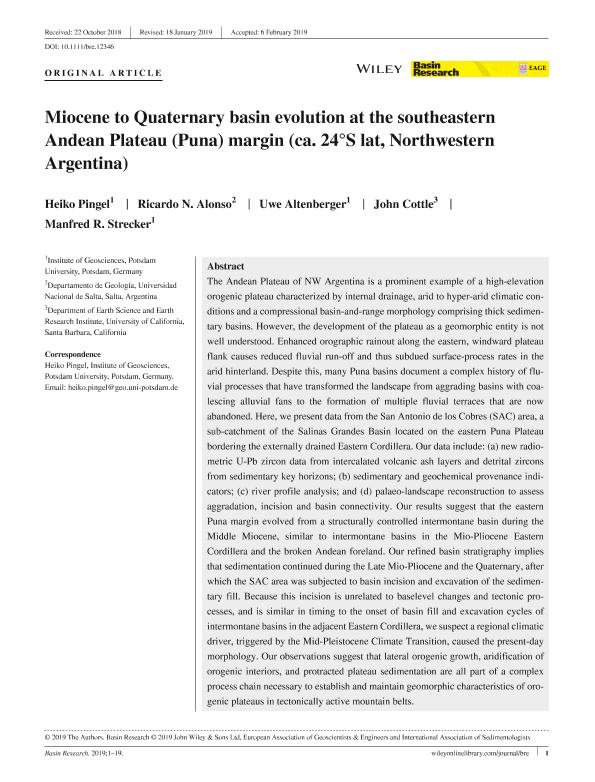Artículo
Miocene to quaternary basin evolution at the southeastern Andean plateau (Puna) margin (ca. 24°S lat, northwestern Argentina)
Fecha de publicación:
12/2018
Editorial:
Wiley Blackwell Publishing, Inc
Revista:
Basin Research
ISSN:
0950-091X
Idioma:
Inglés
Tipo de recurso:
Artículo publicado
Clasificación temática:
Resumen
The Andean Plateau of NW Argentina is a prominent example of a high-elevation orogenic plateau characterized by internal drainage, arid to hyper-arid climatic conditions and a compressional basin-and-range morphology comprising thick sedimentary basins. However, the development of the plateau as a geomorphic entity is not well understood. Enhanced orographic rainout along the eastern, windward plateau flank causes reduced fluvial run-off and thus subdued surface-process rates in the arid hinterland. Despite this, many Puna basins document a complex history of fluvial processes that have transformed the landscape from aggrading basins with coalescing alluvial fans to the formation of multiple fluvial terraces that are now abandoned. Here, we present data from the San Antonio de los Cobres (SAC) area, a sub-catchment of the Salinas Grandes Basin located on the eastern Puna Plateau bordering the externally drained Eastern Cordillera. Our data include: (a) new radiometric U-Pb zircon data from intercalated volcanic ash layers and detrital zircons from sedimentary key horizons; (b) sedimentary and geochemical provenance indicators; (c) river profile analysis; and (d) palaeo-landscape reconstruction to assess aggradation, incision and basin connectivity. Our results suggest that the eastern Puna margin evolved from a structurally controlled intermontane basin during the Middle Miocene, similar to intermontane basins in the Mio-Pliocene Eastern Cordillera and the broken Andean foreland. Our refined basin stratigraphy implies that sedimentation continued during the Late Mio-Pliocene and the Quaternary, after which the SAC area was subjected to basin incision and excavation of the sedimentary fill. Because this incision is unrelated to baselevel changes and tectonic processes, and is similar in timing to the onset of basin fill and excavation cycles of intermontane basins in the adjacent Eastern Cordillera, we suspect a regional climatic driver, triggered by the Mid-Pleistocene Climate Transition, caused the present-day morphology. Our observations suggest that lateral orogenic growth, aridification of orogenic interiors, and protracted plateau sedimentation are all part of a complex process chain necessary to establish and maintain geomorphic characteristics of orogenic plateaus in tectonically active mountain belts.
Archivos asociados
Licencia
Identificadores
Colecciones
Articulos(CCT - NOA SUR)
Articulos de CTRO.CIENTIFICO TECNOL.CONICET - NOA SUR
Articulos de CTRO.CIENTIFICO TECNOL.CONICET - NOA SUR
Articulos(INSUGEO)
Articulos de INST.SUP.DE CORRELACION GEOLOGICA
Articulos de INST.SUP.DE CORRELACION GEOLOGICA
Citación
Pingel, Heiko; Alonso, Ricardo Narciso; Altenberger, Uwe; Cottle, John; Strecker, Manfred R.; Miocene to quaternary basin evolution at the southeastern Andean plateau (Puna) margin (ca. 24°S lat, northwestern Argentina); Wiley Blackwell Publishing, Inc; Basin Research; 31; 4; 12-2018; 808-826
Compartir
Altmétricas




